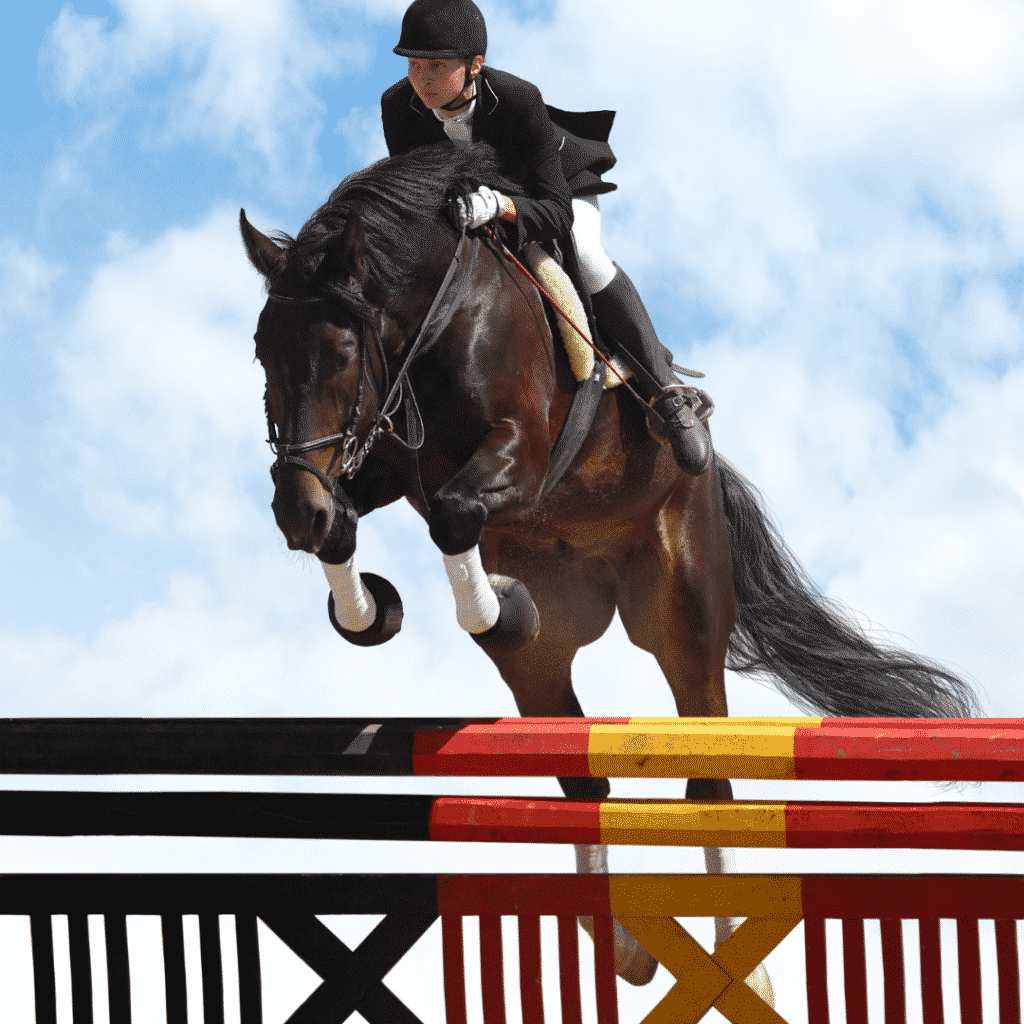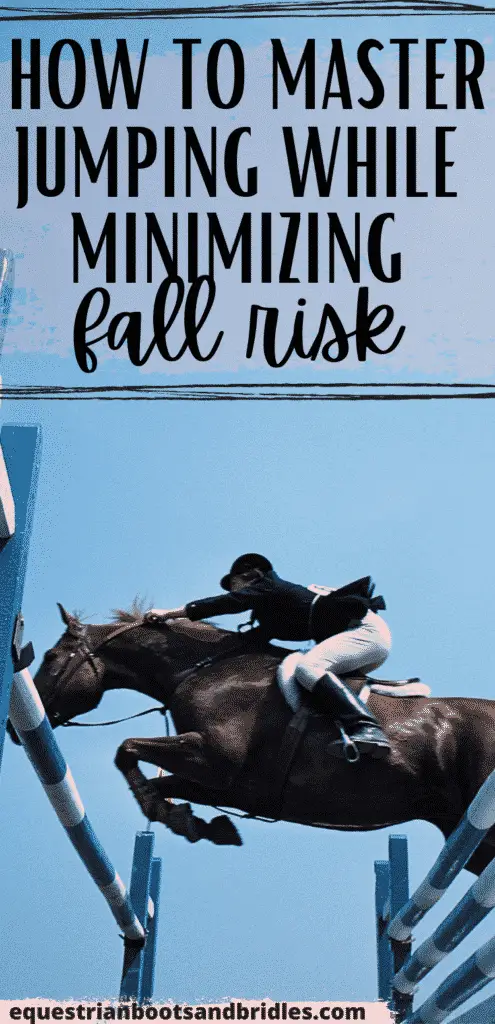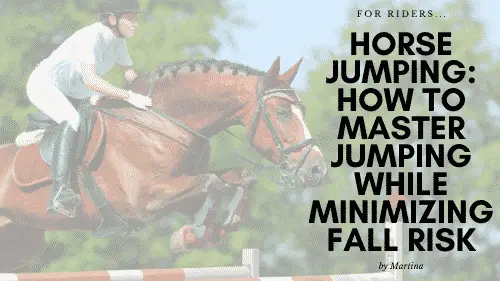Horse jumping is one of the most fun, most freeing things you can do while horseback riding. Watching horses jump at a show or in the olympics is mesmerizing as they manage to clear fences with ease and grace.
Of course, watching horses jump high is also nerve wracking.
If any little thing goes wrong, both the horse and the jumper are in trouble.
We’ve also all seen the memes of riders falling straight into stone wall jumps and doing flips right over their horses.
Learning to jump on a horse for the first time is both scary and exciting.
We’ve all fallen off and falling off into a jump seems worse. Sometimes, it is worse. It really depends on how solid that jump is and which way you fall into it.
I go into detail about the 2 things that have helped me SO MUCH when I was learning to jump in my 100% FREE Beginner Rider’s Ebook: Click here to learn more!
Horse Jumping is All About Tackling Fear
When you’re first learning to jump, or learning to re-jump after a long break, or if you’ve had a bad fall while jumping, jumps can be nerve wracking.
I know no one talks about it or wants to admit it, but I know I went through a period where I was scared of jumping after my bad fall with Dash. I’ll tell you about that in a second.
I first learned to jump on my black feisty pony, Satchmo and I had absolutely no fear. My connection with him was such that I trusted him absolutely. We were such an amazing team.
At that time, I was so young, I didn’t really understand that there was anything to be afraid of. I didn’t understand any of the dangers associated with horseback riding. I also had just such a great bond with Satchmo and rode him for years and years.
It was much later when I was trying to get Dash used to jumping that I developed my fear (the hot, anxious horse I told you about in the “How to Slow Down your Horse” blog – click here to read more). Dash caught the tip of his front hoof on the top of a cavalleti while I was just walking him over to get used to it and spooked so badly he bucked me off.
As you can imagine, pushing myself after that to keep trying to get him used to jumps was a daunting task.
I had ridden plenty of horses who refused jumps. The difference was that they would typically refuse because they were slower to get moving. I was using a lot of leg to get them forwards.
Once I lost some of that leg power as I shifted into two-point, the horse slowed right back down. If the jump was small enough I would walk him over it. Otherwise, I’d circle him around and try again.
Dash, however, was terrified of jumps.
He wasn’t mine, I was just leasing him and his owner didn’t believe that he needed to work on his sensitivity. She was determined to get him jumping and get him jumping fast.
We’ve all fallen off and falling off into a jump, after a jump, or jumping in general is the worst. We’ve also all seen the memes of riders falling straight into stone wall jumps and doing flips right over their horse
OUCHHHHH. Am I right? (No wonder non-horse people call us crazy!)
I was actually riding Dash and Lucy (the horse who I struggled with flexion with – click here to read more) around the same time. I was progressing really quickly with Lucy and was getting close to 4 feet cross-country jumps but with Dash, we were struggling just with poles and tiny jumps because he was so nervous around everything.
I wish I knew now what I knew then about emotional control so I could have worked on that with him but hopefully it can help you if you feel your horse could use some! At the time, I was told by someone I trusted to keep pushing him with the jumps so that’s what I did. If I could go back and re do it, I would do it differently.
Just goes to show that if you feel unsafe with your horse or the horse you’re riding, you’ve got to really think about whether your fear is real or whether it’s in your head. With Dash, my fear was real but that fear of jumping translated to Lucy (who was a sweetheart) and that fear was imagined. Trust your instinct and don’t be afraid to ask other people their opinion if you’re being asked to do something you feel uncomfortable with.
Eventually, I stopped working with Dash because I knew it was unsafe (I had real fear) without doing some serious training with him. He needed to go back to basics and his owner wouldn’t hear of it.
Anyways! Side-tangent over now…Lol
So after Dash’s spook, I started to develop a fear around jumping I had never experienced before and it was SO frustrating. Especially since I had to (or felt like I had to ) keep pushing him with the jumps.
I had fallen off horses before but I think it was because this fall was very out of the blue for me. We literally were walking over the jump when he spooked.
For a while after that, I was more hesitant around jumping (with all horses) and every time I went over high jumps just a little bit off so that I would shift in my saddle, or fall forwards a bit or loose my stirrups at all, I would get nervous. So I came up with a few ticks that I use now whenever I’m jumping to minimize loosing balance over jumps and minimize falling risk. Hopefully they help you too!

Jumping is a very mental exercise. Whether you’re just learning to jump, re-learning to jump after a long break or you’ve recently had a bad jumping experience, your thinking will really impact your success.
Is it Safe to Jump and Should I be Horse Jumping?
Don’t be ashamed if you’ve asked yourself this question before.
As equestrians, we tend to be very stoic about these types of things. It’s only natural to have concern for our own safety!
Thinking of my safety, my mom used to harp on me when I was growing up that I should do more dressage. Unfortunately for her, I just love jumping too much to ever give it up.
Jumping is safe if you take the certain precautions.
If you’re able to answer yes to all the following questions then YES! You should be jumping!
- Is your horse at an appropriate level for jumping?
- Can you establish a controlled canter from the trot at will?
- Are you able to slow your horse down?
- Is it easy for you to turn, perform circles and establish flexion appropriately?
- Are you able to hold the two-point position for a stretch in the trot and in the canter?
Following the next steps will teach you my techniques for jumping that have helped me curb my falls significantly. The techniques also helped me to get over my mental block after riding the horse that bucked me off after walking over a cavaletti.

Do you want to fall less and jump more?
What a silly question, of course you do!
So let’s get to it.
How to Master Jumps with Minimal Falling Risk
This is the technique I used to help me get over my fear of falling off while jumping.
Tip #1: Constantly Stay in Two-Point. Two-point Coming into the Jump and Leaving the Jump.
First, make sure that you can two-point well enough to ride a figure-8 or a 4-clover pattern with no problems around the arena.
Practice these patterns at a trot when you’re riding before you start jumping.
To balance in your two-point at a trot, use your inner lower legs to squeeze if needed and use your reins to steer because your seat and single-leg aids are mostly out of commission.
Once you’re able to basically trot around normally in a two-point, you’re going to put poles into your pattern. Start with 1 and work up to 2.
Remember to look straight ahead and don’t change absolutely anything about your position. Pretend you’re just riding your pattern. It’s your horse’s job to do the rest.
Once you’ve done 2 poles, change the 2nd pole into a very low X jump or a cavaletti and repeat at a trot.
Again, remember to look straight ahead and don’t change absolutely anything about your position. Pretend you’re just riding your pattern. It’s your horse’s job to do the rest.
Eventually you can graduate to bigger jumps, more jumps, a more intricate pattern and even doing them at a canter.

The perk of coming into the jump and going out of the jump at the two-point rather than sitting before and after is that it is almost impossible to fall out of a stable two-point. Your legs are shock absorbing all of your horse’s movement.
He can switch directions, refuse the jump or buck a little and you’ll be able to shock absorb the movements.
Your weight is so far into your heels and you’re body is free to shift as needed to keep your balance.
Furthermore, in the two-point, you can grab a fist-full of mane the whole time if you need to. Don’t worry what you look like! That’s the whole point of practice.
Although this particular hack won’t make you look like a pro show-jumper, being able to hold and ride in two-point is key for cross-country and transitioning in and out of two-point will become much easier once you’ve improved your confidence sufficiently to do so.
How to Stop Falling Forwards After High Jumps
This is a more advanced technique because I find that it only starts to become relevant with higher jumps. That being said, it’s also very useful if your horse refuses a jump at high speed.
Does Jump Height Really Matter?
A lot of coaches say that height doesn’t matter when jumping; you take your two-point and the horse does the rest.
Personally, I just don’t think that’s true.
Jumping higher means:
- Increased power and acceleration from the hindquarters
- Increased angle of take off and landing
- Greater impact on landing
- Bigger mental barrier
Riders tend to mentally anticipate a big jump.
I know I used to!
I would move forwards with my shoulders more. Then when my horse landed, his lower legs kicked back and my whole body was pitched forwards.
You can probably see my mistake at a mile away.
I flipped right over the horse’s shoulders.

Let me tell you, it is not fun at all to flip right over after these kinds of jumps.
On the bright side, it is also avoidable!
Tip #2: Think “shoulders up and back”.
Thinking “up and back” is not intuitive in two-point.
In fact, people tell you to lean forwards or put your shoulders forwards.
This doesn’t make much of a difference when you’re jumping small fences. But when the height starts to increase, you won’t be able to balance the landing if your shoulders and weight are too far forwards.
I want you to try something different and see if it helps you. It certainly helps me! High jumps and refusals don’t phase me anymore.
I want you to give yourself the following cues:
- Heels down and weight in your heels (think “weight down” rather than forwards or backwards)
- Shock absorb any movement with ankles, knees and hips
- Back arched/concave and bum “out” slightly
- Shoulders up and rolled back with chest up
Your 2 points of contact are the insides of your lower right above your inner ankle joint. That’s what’s going to keep you connected to the horse so you want to make sure your weight is down in your heel so you feel as solid as possible in that connection.
Note: In order to get the weight down into your heels properly and shock absorb when landing a high jump, it’s really important to have adequate ankle mobility.
Check out these two articles if you feel ankle mobility might be an issue for you:
- English Riding Tips on Ankle Mobility, Heels Down!
- English Riding Tips: Exercises for Ankle Mobilization
If you’re REALLY struggling with ankle mobility and lower leg position, e-mail me directly as I’m currently working on a complete course on how to go from 0 to excellent ankle mobility and complete lower leg stability when riding. I’ll give you access to a great deal when the course launches (no obligations, of course)!

If you have your chest up during the whole jump, you won’t need to lean backwards as drastically during landing.
When you’re landing a bit harder or from a higher arc, it’s much more difficult to correct for the momentum if your shoulders are already leaning forwards. This causes your lower legs to kick back, the weight is no longer in your heels and the result is that you come forwards, which in turn increases your chances of falling off.
So remember, think “shoulders up and back” with your chest up rather than “shoulders forward” or “lean forwards”.
You are officially ready to go and conquer those jumps!
Let me know how you go in your next horse jumping session. I would love to hear 🙂
If you enjoyed this post, you might enjoy my FREE Beginner Rider’s EBook! You’ll learn how to keep a consistent pace (whether you’re riding a fast or slow horse), how to make smoothen transitions, how to finally get the flexion and bend you want, The Emergency Brake as well as bonus chapters on making cantering and jumping so much easier!
Sign-up below and I’ll send you access for free:
Liked this post? Why not pin it!


